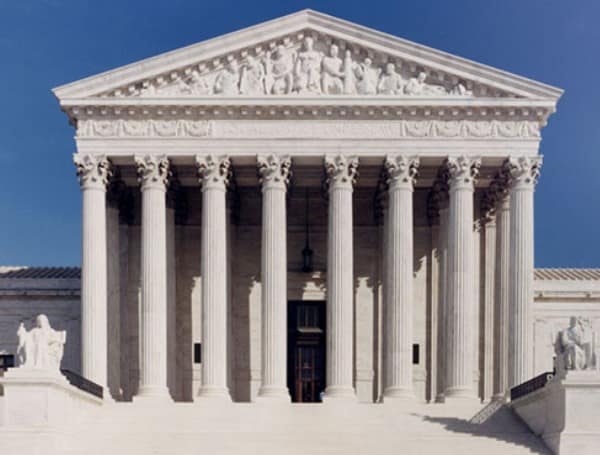The Supreme Court’s definition of a “true threat” in an upcoming case could have broad implications for a range of speech from online jokes to religious expression.
Justices will soon hold oral arguments for Counterman v. Colorado, which asks how a speaker’s intent should be considered when they are accused of making a “true threat” — speech that is unprotected by the First Amendment. It’s a question of importance for a range of different people — religious freedom, child advocacy, and civil liberties groups have all filed friend of the court briefs.
The case itself revolves around Billy Raymond Counterman, who was sentenced to four and a half years in prison for repeatedly sending a local musician Facebook messages she found threatening, such as “Die,” “Fuck off permanently,” and “Was that you in the white Jeep?” according to court documents.
In the news: Gen Z Traded Church For ‘A New Religion,’ Faith Leaders Say
The Colorado Court of Appeals found that a “reasonable person” would understand the statements to be threatening, but Counterman argues that was not his intent. He asks the Supreme Court to consider a speaker’s metal state, rather than the recipient’s emotions, when weighing crimes against “pure speech.”
We filed our opening brief in Counterman v. Colorado, involving whether there’s a constitutionally required minimum level of intent to be convicted of making a threat. To be argued April 19.
Foundation for Individual Rights and Expression (FIRE) Attorney Gabe Walters, who filed a brief in the case, says Supreme Court precedent and free speech principles “require that the speaker actually intend to cause a person or group of people fear of harm” to be punished.
“Otherwise, speech that is politically or socially unpopular, or even just intended as a joke, will too easily be punished, as in the example of Meredith Miller, who joked on a social media app that she would detonate the University of Utah’s nuclear reactor, which is too small to detonate, if the Utes lost their upcoming football game,” Walters told the DCNF. “The university argued that her actual intent in making that statement was irrelevant as it sought to suspend her for two years.”
In the news: High Inflation And Housing Costs Force Many Americans To Delay Needed Care
The Alliance Defending Freedom (ADF), which filed a brief in support of neither party, acknowledges the government’s interest in protecting its citizens but warns the Court against “[opening] the door to restricting speech based on its effect on the recipient.”
“While the conduct of certain individuals may warrant punishment, the government should be able to criminalize speech only in very rare circumstances,” Travis Barham, senior counsel at ADF, told the Daily Caller News Foundation. “Attempting to prosecute speech is a slippery slope, and courts should make clear that the state cannot criminalize speech without first considering the speaker’s intent. We are seeing an increase of ‘speech is violence’ rhetoric in our society, particularly in higher education, and it is critical that the Supreme Court not embrace this arbitrary concept and instead reiterate the First Amendment’s broad protections for free speech.”
The brief cites three cases where religious viewpoints were penalized on college campuses because they caused emotional offense.
“Just sharing with people how Jesus Christ died on the cross and rose again to give them eternal life was enough for officials to accuse [Chike Uzuegbunam] of engaging in fighting words—all because he allegedly disturbed someone’s ‘peace and/or comfort,’” the brief says. “But given this reality—and the ‘speech is violence’ mentality that afflicts too many administrators—allowing true threats to fluctuate based solely on the reasonable person is dangerous.”
We can’t do this without your help; visit our GiveSendGo page and donate any dollar amount; every penny helps.
Other briefs raise similar concerns. The American Civil Liberties Union (ACLU) argues that the Court must acknowledge intent to “prevent speech from being unduly chilled.”
“A vast amount of speech on political, social, and other issues occurs online, and is often abbreviated, idiosyncratic, decontextualized, and ambiguous,” it says. “Much of this online speech such as public posts on major social media platforms like Twitter and Facebook—is accessible by anyone with an Internet connection, meaning the foreseeable audience is broad, diverse, and likely to interpret the speech in myriad ways the speaker never intended.”
Human Rights For Kids explores the impact on children in its brief, arguing that allowing the government to criminalize speech without accounting for intent would “disproportionately harm children, who, because of their under-developed brains and impetuous nature, are more likely to engage in speech that a reasonable person would find offensive, abrasive, or threatening.”
Some legal scholars, however, believe the entire threats discussion is misguided.
Three professors argue that Counterman is not a case about threats at all, but a case about stalking, a difference that impacts the First Amendment analysis. Stalking laws “prohibit a pattern of conduct, sometimes involving speech” but do not restrict speech based on content, they say.
“This Court should therefore affirm Mr. Counterman’s conviction, but on a different basis than that relied upon by the Colorado Court of Appeals,” they argue. “Specifically, it should affirm Mr. Counterman’s conviction under Colorado’s stalking law not because one or more of his messages amounted to a ‘true threat’; but rather because the First Amendment is not violated by a defendant’s conviction for a course of conduct involving hundreds of direct communications to a single individual that reasonably caused the target serious emotional distress.”
Android Users, Click To Download The Free Press App And Never Miss A Story. Follow Us On Facebook and Twitter . Signup for our free newsletter .
We can’t do this without your help; visit our GiveSendGo page and donate any dollar amount; every penny helps.



